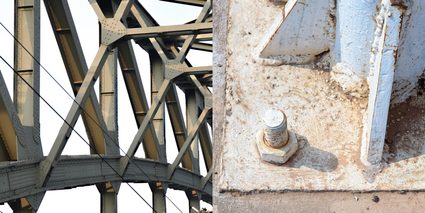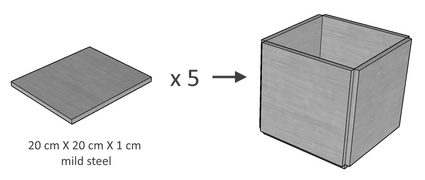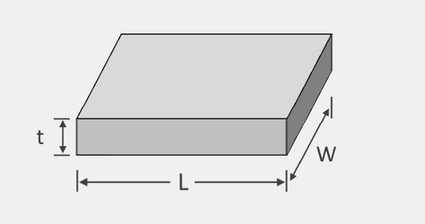Steel Plate Weight Calculator
This steel plate weight calculator will help you determine the weight of steel plates, no matter their area and thickness. This calculator is an extension of our steel weight calculator but focuses on steel plates. We equipped this calculator with the same list of common steel alloys to provide you with your steel plate's weight.
In this steel plate calculator, we will briefly describe what steel is and how to measure a steel plate's weight using its density and volume. You will also learn about some uses of steel plates. So what are you waiting for? Let's get started!
🙋 If instead, you need to know the weight of other metals like aluminum or gold; we have our separate aluminum weight calculator and gold weight calculator you can use, respectively, to learn more about how to calculate them.
What is steel?
Steel is a metal alloy comprised of iron and carbon. The presence of carbon makes steel stronger and more resistant to breaking. The more carbon in the steel, the stronger it gets.
Adding other alloying elements to steel can even improve the steel's ductility, hardness, durability, corrosion resistance, and much more. To learn more about this, check out the what is steel? section of our steel weight calculator.
Steel plates and some of their uses
Steel plates have many uses, most notably in the construction and fabrication of various steel products. We can cut steel plates into many shapes, punch them, drill holes in them, and bolt them together for movable connections, or forego the drilling entirely and weld them together for a fixed connection.
Steel plates have a variety of purposes: as gusset plates in trusses, as flanges and fin support for posts, and in the fabrication of pressure vessels such as boats, ships, and even military vehicles.

How important is knowing the weight of steel plates?
Like other raw materials such as gravel, sand, and concrete, steel is also commonly priced per unit weight. Since we can purchase steel in various types, shapes, and sizes, pricing steel per unit weight is easier and creates consistent pricing within the market. This way of pricing is the reason we calculate the weight of steel in general.
Determining the total weight of the products we purchase, including steel plates, helps us properly plan their transport from the supplier's warehouse to our project or fabrication site. Aside from these reasons, knowing the weight of the steel plates we use in our projects can also help us work out if we can lift the final product, like the one we illustrated in the sample computation of steel weight section of this text.
How to measure steel plate weight?
Determining the weight of steel plates is so easy. First, we need to know the density of the steel alloy our plate is made of. In our steel plate weight calculator, we have the densities of the most common steel alloys found in the Steel type field. As a reference, here is a table of the density of each steel alloy or steel type in our steel plate calculator:
Steel type | Density (kg/m³) |
|---|---|
Tool steel | 7715 |
Wrought iron | 7750 |
Carbon tool steel | 7820 |
Cold-drawn steel | 7830 |
Carbon steel | 7840 |
C1020 HR steel | 7850 |
Pure iron | 7860 |
Mild steel | 7870 |
Stainless steel | 8030 |
After we've determined the density of our steel plate, the next step is to obtain the total volume of our steel plate. We can do this in a variety of ways, but the easiest is to get the area of our plate and multiply it by the plate's thickness. After obtaining the volume of our steel plate, we can now multiply this volume by our steel plate's density to calculate its weight, as shown below:
steel plate weight = steel plate volume × density
If you need to calculate multiple steel plates of the same dimensions, you can input the number of steel plates you have into our steel plate weight calculator to get the total steel plate weight. How about we consider an example to better understand how to calculate steel plate weight?
How does the steel weight plate calculator work?
For our example, let us determine the weight of the steel plates that we would need to build, say, a mold for cube-shaped concrete blocks. For our mold, we need to cut 5 squares, each with 20 cm sides from a 1-cm thick mild steel (7,870 kg/m³) plate as shown in the illustration below:

To solve the weight of these cut steel plates, let us first calculate the volume of the steel plate by multiplying its dimensions together. Since we already know that the density of mild steel is in kilograms per cubic meter, let us solve the steel plate volume in cubic meters. The 20-centimeter side is equal to 0.2 meters, and the 1-centimeter thickness is equal to 0.01 meters. So, we can find the volume of a single piece of square plate:
steel plate volume = 0.2 m × 0.2 m × 0.01 m
steel plate volume = 0.0004 m³
Solving for weight, we have:
steel plate weight = steel plate volume × density
steel plate weight = 0.0004 m³ × 7,870 kg/m³
steel plate weight = 3.148 kilograms
However, since we need five pieces of this square steel plate, the steel plates' total weight would then be 3.148 kg × 5 = 15.74 kilograms. That's a lot of weight for just a small piece of cube mold!
🔎 If you just want to purchase concrete blocks from a supplier, you can use our concrete block calculator to determine how many concrete blocks you'll need for your project.
Want to learn more?
If you've found our steel plate weight calculator informative, you might also like our metal weight calculator. There, you can learn more about other metals, how to calculate their weight, their densities, and also some of their uses.
FAQs
What is steel plate?
Steel plate is a material commonly used in the construction of buildings to create everyday objects like ship hulls. It is produced in different thicknesses and widths, then cut and welded together to create the final product. Depending on the type of steel used, there are different types of sheet metal, such as stainless steel and high-carbon sheet.
What are the other shapes of steel?
Other shapes of steel you may encounter are:
- Bars (round, square, or flat) — typically used for construction;
- Sheets — a flat, thin pieces of steel;
- Angle sections — has the "L" shape;
- T-sections — arranged in a “T” shape; and
- I-sections — consists of two flanges joined in the "I" shape.
How can I calculate the weight of a steel plate?
Follow these steps:
-
Determine the type of steel and find its density.
-
Measure the dimensions of your steel plate: thickness, width, and length.
-
Calculate the plate volume:
volume = thickness × width × length
-
Multiply by the specific density of the steel type:
weight = volume × density
How much does a 1/4-inch of stainless steel plate weigh?
The weight is 151.6 kg or 334.2 lbs, assuming that your 1/4-inch thick stainless steel plate has a 48-inch width and 96-inch length. To calculate it:
-
Convert inches to meters:
1/4 in = 0.00635 m, 48 in = 1.2192 m, 96 in = 2.4384 m
-
Find the plate volume:
0.00635 m × 1.2192 m × 2.4384 m = 0.0189 m³
-
Multiply by the density of stainless steel:
0.0189 m³ × 8030 kg/m³ = 151.8 kg
What is the standard size of steel plate?
Steel plates are typically produced in widths of 36", 48", and 60", and lengths of 96", 120" and 144". Steel plates are usually thicker than sheet metal and typically measure more than 6 mm (0.2362 in) thick.
